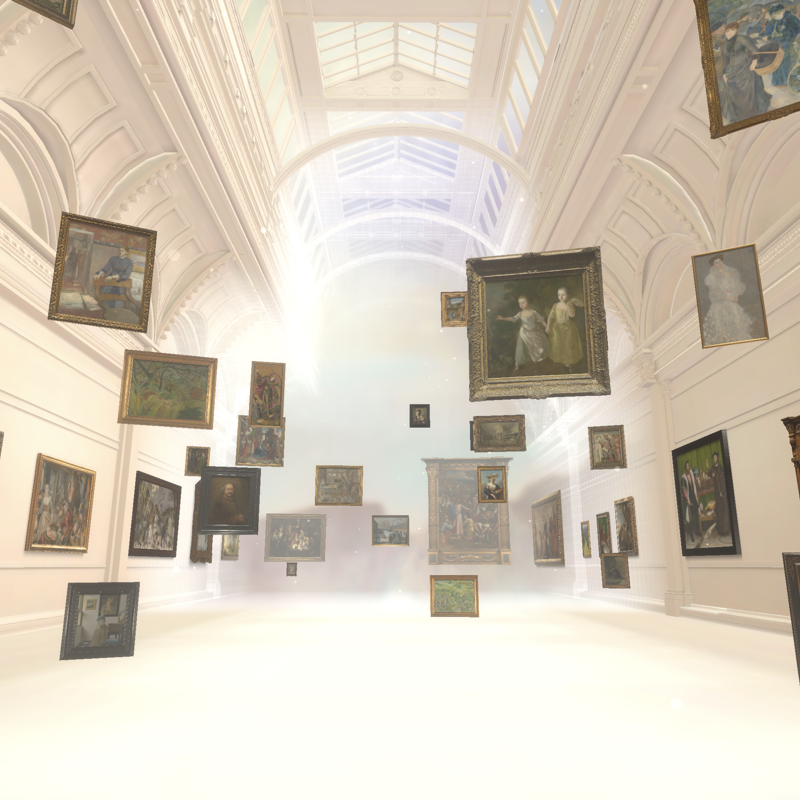Eva Gonzalès, 'The Full-length Mirror', about 1869-70
About the work
Overview
In a simple bare room, featuring only three objects, a sofa, a full-length mirror and a picture on the wall, a young woman stands in quiet contemplation of her appearance. She wears a striped dress with an overdress of a pale grey, tied in a bow at the waist with a black fringed scarf. Her hair is piled up with one plait at the back. She holds her hands together, grasping a small red flower, the only touch of bright colour in the picture.
Depictions of young women at their mirror were popular among the Impressionist painters, and painted by both Edouard Manet (1832‒1883) and Berthe Morisot (1841‒1895). This subject can be placed in a much longer tradition of images of women at their toilette, often presented in the guise of Venus, the personification of female beauty, admiring herself in a mirror, as in The Toilet of Venus (‘The Rokeby Venus’) by Diego Velázquez.
The young woman is Gonzalès’s younger sister Jeanne, also an artist and her constant model throughout her career. The subject is typical of her portrayals of young women which were shaped by the work of her first teacher Charles Chaplin and her second, Manet. It is probable that Gonzalès painted this in around 1869‒70, just after she became Manet’s only formal pupil.
Key facts
Details
- Full title
- The Full-length Mirror
- Artist
- Eva Gonzalès
- Artist dates
- 1847-1883
- Date made
- about 1869-70
- Medium and support
- oil on canvas
- Dimensions
- 39 × 26.5 cm
- Inscription summary
- Signed; Inscribed
- Acquisition credit
- Bought thanks to generous legacies from Mrs Martha Doris Bailey and Mr Richard Hillman Bailey, Miss Gillian Cleaver, and Ms Sheila Mary Holmes, with the support of the National Gallery Trust, 2024
- Inventory number
- NG6702
- Location
- Room 41
- Collection
- Main Collection
- Frame
- 18th-century French Frame
Provenance
The painting was in the collection of Edouard Dentu (1830 – 1884) in Paris until his death in 1884. It then passed to his estate until 1885, when it was inherited by his widow, Louise Léonie Dentu (née Faure-Decamps, 1842 – 1914), who kept it in Paris and possibly later in Cap d'Ail. The subsequent history until 1952 remains unclear, but by that year, it had come into the possession of Camille Félicie Leroux (Mme Camille Haudebert/Hodebert, 1875 – 1953). The painting was sold at auction at the Hôtel Drouot in Paris on 29 May 1952 (lot 115) to an unrecorded buyer. On 13 November 1952, it was acquired by Arthur Tooth and Sons Ltd, London, who sold it on 30 November 1953 to a private collector in the United Kingdom. The painting remained with their family by descent until 2024, when it was purchased by the National Gallery with funding from generous legacies from Mrs Martha Doris Bailey and Mr Richard Hillman Bailey, Miss Gillian Cleaver, and Ms Sheila Mary Holmes, with additional support from the National Gallery Trust.
Questions 1933 – 1945:
Provenance between 1885 and 1952 is not documented
Circumstances and method of acquisition by Camille Félicie Leroux are unknown, as well as where she kept the painting
Additional information
This painting is included in a list of works with incomplete provenance from 1933–1945; for more information see Whereabouts of paintings 1933–1945.
Carlo Corsato, 14 March 2025
About this record
If you know more about this work or have spotted an error, please contact us. Please note that exhibition histories are listed from 2009 onwards. Bibliographies may not be complete; more comprehensive information is available in the National Gallery Library.

